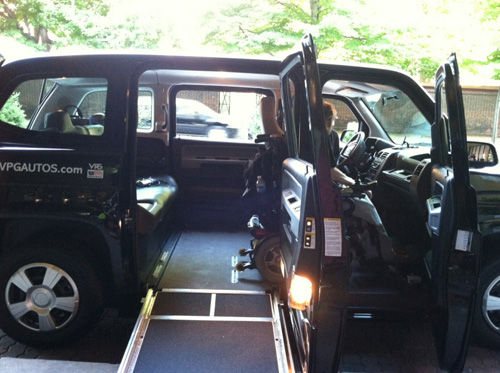MV-1 would offer disabled vets new accessible transportation options that they don’t have today, and it’s made in America.
I recently attended a conference of the Association of Travel Instruction, and was joined by the Vehicle Production Group, www.vpgautos.com, who brought along their new MV-1 vehicle––the first-ever, factory-built wheelchair accessible automobile.

MV-1 with ramp deployed. Ooh-rah!
During my career at VetsFirst/United Spinal Association, I did quite a bit of public transportation accessibility advocacy. That’s how I became involved with travel trainers in New York City and why I started advocating for accessible cabs here. After all, more taxis operate in New York than in any other city in the nation.
It’s also why I contacted VPG and asked them to bring one of their new MV-1 vehicles to the Travel Instruction meeting. Members of the Association of Travel Instruction teach seniors and people with disabilities how to use public transportation services safely and independently.
Clearly, the developers of the MV-1 were not just thinking about the wheelchair users of today but also considered the aging of America in the years ahead. Another very cool aspect of the MV-1 is that it is being “made in America,” at an AM General plant in Mishawaka, Indiana, that still manufactures the Humvee for the military.
Production of the MV-1 has begun and delivery to its first customers will start by the end of September.
I have been in an MV-1 prototype on a number of occasions, including at its August 2006 unveiling at a taxi owners conference in Seattle. This vehicle was originally intended to be an accessible taxi so it will come off the assembly line as solid as a rock. We all know that if nothing else, taxis must be durable. However, others will be purchasing this vehicle, too, including public transportation agencies that must provide Americans with Disabilities Act paratransit service, and individual citizens like you and me.
I see lots of possibilities for the MV-1 and disabled vets, too. For instance, whenever I make an outpatient visit to the Bronx VAMC, I notice many vets with disabilities arriving and departing via local ADA paratransit service, which is very expensive to provide. The use of the MV-1 in ADA paratransit services everywhere could reduce VA transportation expenses considerably. In communities across the land where private taxi service is already available, including a reasonable number of MV-1 taxis would offer disabled vets a new accessible transportation option that they don’t have today.
Of course, it’s obvious that individual veterans with disabilities can purchase the MV-1 for personal use. One other very important potential of this vehicle, to me, is that it could become a new accessible transportation vehicle in rural and suburban areas where little or no “public” or “private” form of transport exists. It might even be a smart disabled vet who purchases one or more of these vehicles and opens his or her own new transportation business.
I’m very hopeful that there will be some MV-1s operating in New York City soon, and in your community, too. You might want to contact your community leaders and taxi companies, asking that they work together to acquire some MV-1s. They might say yes.
Terry Moakley
Chair of the VetsFirst Committee
